10 Simple Ingredients For Lifelong Fat Loss
February 6, 2017
Basic, simple principles are the drivers of success in both fitness and business. But as anyone who’s struggled with a diet can tell you, simple doesn’t mean easy.
This post provides you with the principles and tools to succeed in losing fat, gaining more energy, and performing your best. But principles and tools don’t tell the whole story. You’ll also need practical strategies if you want to successfully lose fat. Luckily, I have the daily lessons and easy-to-implement strategies for you here.
1. The Law of Caloric Restriction You must restrict calories to trigger fat loss. The most basic rule of fat loss is governed by energy balance.
Energy balance is the relationship between energy in, the calories consumed via cheeseburgers (food) and coffee (drinks) and energy out.
Energy out is the calories burned through daily energy requirements and exercise.

Basically, if you’re burning more calories than you’re consuming, you should rapidly lose fat. This is an oversimplification because the human body is complex. At their root, all successful fat loss diets focus on caloric restriction to help you lose fat and look good naked.
Examples: The Slow Carb Diet: The slow carb diet eliminates most starchy carbs, sugars, and fruits to limit the number calories you take in per day.
The Atkins Diet: The Atkins diet severely limits carbohydrate intake to restrict eating options and drive caloric intake down.
Intermittent Fasting: Intermittent fasting limits the amount of time you can eat in a day, making it damn near impossible to eat too much. There are many other diets and fat loss methods. At the heart of them all is eating fewer calories than your body burns.
2. The Law of “Why”
Wanting to lose fat isn’t enough. You need a “why.” Do you want to lose fat and keep it off for good? How about getting shredded and seeing your abs? These are common goals, but they aren’t enough to sustain a diet. To lose fat you need to know “why” losing fat matters to you. It doesn’t matter whether you’re trying to get ripped for the beach or lose forty pounds to be healthier and happier.
These are common goals, but they aren’t enough to sustain a diet.
To lose fat you need to know “why” losing fat matters to you. It doesn’t matter whether you’re trying to get ripped for the beach or lose forty pounds to be healthier and happier. 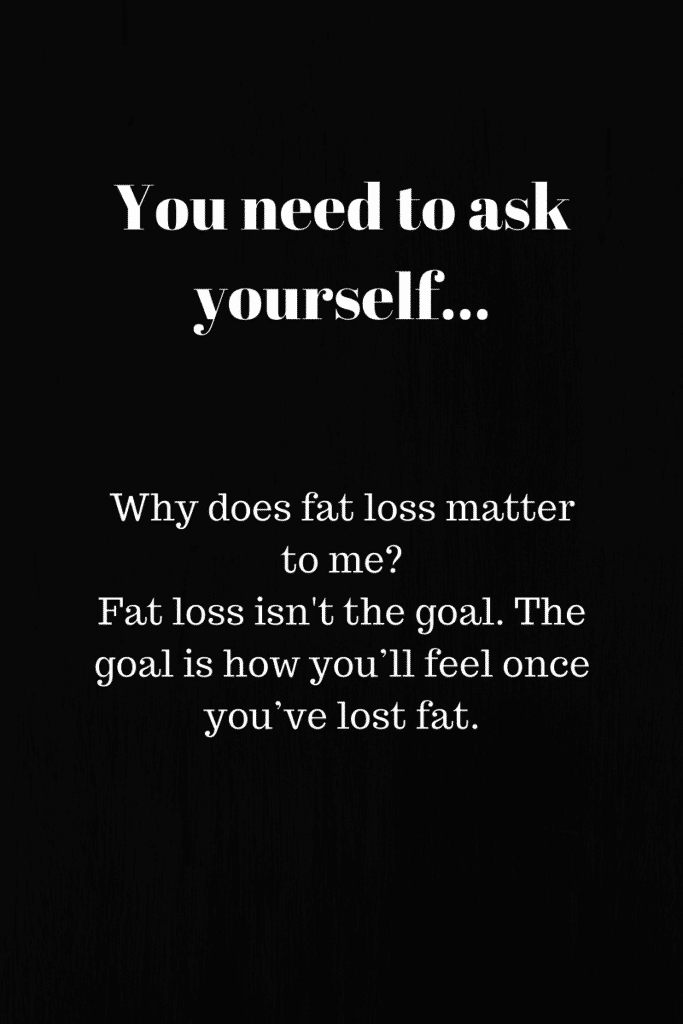 Take a conversation I had with one of my clients. It went something like this. Me: “You mentioned in your application you want to lose fat and see your abs for the first time.
Take a conversation I had with one of my clients. It went something like this. Me: “You mentioned in your application you want to lose fat and see your abs for the first time.
That’s great, but let’s dig deeper.
Why do you want to lose fat and see your abs?”
Client: “Well, I have a vacation to the beach with friends at the end of April. I was always chubby growing up. Now I want to wow them.” Me: “Wow, that’s great. Can I ask why you want to wow them?”
Client: “Well, I girl I used to date, Jenna, is going to be there. She didn’t find me as attractive as when we first started dating…although she never said anything. If I lean out and see my abs, I’ll be more confident and who knows, maybe Jenna and I will start talking again.”
The takeaway? Fat loss isn’t the goal. The goal is how you’ll feel once you’ve lost fat.
This “why” is what pushes you to persevere through the tough workouts and hunger pangs to stay the course. Dig deep and find out the “why” behind your motivation. You won’t always like what you find, but it’s what you need to do to lose fat and keep it off.
3. The Law of Satiation
Eating a high protein and high fiber diet is a pillar for successful fat loss as protein boosts muscle retention (so your muscles look defined once you’re lean) while both fiber and protein keep you full.
So, what’s the secret sauce that makes protein and fiber so important? Fiber is difficult for your stomach to digest. It takes up a lot of room in your gut and triggers receptors in your brain to tell you-you’re full. Even better, fiber slows the release of insulin in your bloodstream.
So fiber is a slam dunk which helps you control blood sugar for faster fat loss and gains in lean muscle.
As a bonus, fiber also improves cardiovascular health, controls diabetes, controls blood pressure, and of course, cleanses your GI tract and give you high-quality poops. 🙂
Eating more fiber doesn’t have to mean consuming more grains. The best weight loss strategy is to replace grains with fiber-rich greens and fruits. At dinner, think about eating steak and asparagus, not steak and a quadruple bacon burger with fries.
So what about protein? Eating a high protein diet is arguably the most important factor in improving your physique. For starters, proteins break down into amino acids.
These are the powerhouse molecules that replace dead cells, support growth and help synthesize other important molecules in your body. Eating a high protein diet can boost glucagon, a hormone released when blood sugar drops to stimulate the breakdown of glycogen (stored carbs) into glucose for your body to help you lose stubborn fat.
Compared to lower protein diets, high protein diets help you retain lean muscle mass during a diet while also keeping you full. To maximize fat loss aim for protein at each meal and aim for at least 1 gram for every pound of bodyweight.
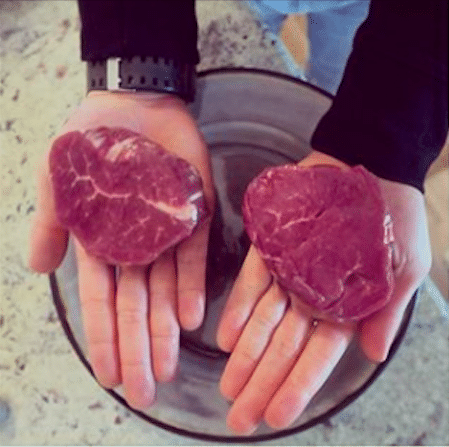
To hit your protein goals, eat lean protein like fish, poultry, lean cuts of beef, and mix in the occasional protein shake.
Eating protein and fiber-rich foods keeps you full and provides your body with essential macros, vitamins, and minerals with fewer calories than most other foods.
To stay full, optimize health, and avoid crushing a bag of Doritos in a diet fueled eating frenzy, crush your lean meats and veggies.
4. The Law of Longevity
Crash diets are temporary fixes, not long-term solutions. Crash diets promise massive fat loss in the shortest time possible. Look no further than the tabloids you see at finer checkout counters everywhere. “Lose Ten pounds in Two Weeks!” “Four Weeks to Fit: Muffin Top Melter” Sure, these are catchy headlines.(I giggled at “Muffin Top Melter.”)
But these not sustainable able methods for lasting fat loss. So, crash diets are useless, right?
Not quite.
Crash diets work for high-level athletes and physique competitors. It can help them get in tip-top shape.
For regular folks, crash diets occasionally work in boosting motivation and building momentum for a diet. But these are the exceptions, not the rule. 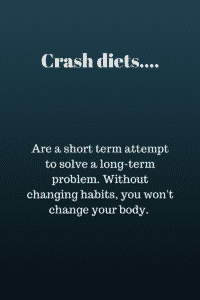
If you want to lose fat and keep it off, then you need a long-term plan, not a hyped up band-aid approach. A better approach is recognizing and modifying the behaviors that got you fat in the first place.
I understand the attraction of following the Grapefruit Diet or whatever shit Gwyneth Paltrow shares on the internet promising 20 pounds off in three weeks.
But this is the exact type of yo-yo dieting that leads you to gain and lose the same 20 pounds year after year.
I follow an approach taught by Precision Nutrition to help my clients tweak one small behavior at a time. This builds long-term, sustainable fat loss. Here’s a sample six week approach:
Weeks 1-2: Focus on drinking one glass of water before each meal For optimal hydration and to keep you full.
Weeks 3-4: Drink a protein shake after your workout Protein intake is strongly correlated with fat loss and dietary success.
Weeks 5-6: Eat a vegetable with each meal. Vegetables are low in calories and high in fiber, vitamins, and minerals to fill you up and give your body the fuel it needs. Simple? Yes.
But simplicity begets consistency, and consistency drives change and fat loss. Ten percent of the time use an aggressive fat loss approach to move the needle and build momentum. Spend the other ninety percent of your time building better habits to lose fat and keep it off.
5. The Law of Imperfect Progress
No diet is perfect. Intermittent fasting. Paleo. Atkins. Mediterranean. South Beach. Ketogenic. The Doughnuts, Bourbon, and Steak Diet. (Okay, I just made that one up.)
But they can all work by restricting choices you so eat fewer calories, more protein, and more vegetables. That’s it.
There is no perfect diet. Don’t fall in love with the fancy marketing methods of any particular diet. Focus on core principles instead. Eat less, move more, crush vegetables, and eat a high protein diet. And if you want to build muscle and lose fat at the same time? Grab this FREE guide.
6. The Law of Reverse Dieting
You can’t diet forever without running the risk of metabolic adaptation. Metabolic adaptation is a change in your metabolism that makes fat loss damn near impossible, even if you’re in a caloric deficit.
Tell me if this sounds familiar: You started a diet and those stubborn love handles disappeared fast.
You lost four pounds the first week. Then, another three in week two. But by week six? Nothing. Zip. Zero. Zilch.
And now you’re pissed and wondering, “Why can’t I lose weight? UGH. ” So, you proceed to eat less and less.
After weeks, months, and sometimes years of undereating in a desperate attempt to lose fat, your metabolism and fat loss comes to a screeching halt.
This is whats referred to as metabolic adaptation. After long-term dieting, your body begins to burn fewer calories to produce the same amount of energy, metabolism decreases, and catabolic hormones like cortisol skyrocket while anabolic hormones can plummet.
What to do instead? First, acknowledge you can’t diet forever. There will always be some metabolic adaption when trying to lose fat. But when fat loss comes to a screeching halt you have two options:
Second, incorporate refeed meals. By increasing the amount of food you’re eating you’ll increase leptin levels to boost your metabolism and give yourself a mental break from dieting.
Third, reverse diet back to maintenance calories. Reverse dieting is the process of increasing your calories over time to minimize fat gain and repair your metabolism following a diet. If you’re coming out of a long-term diet and looking to maintain weight loss, reverse dieting is likely your best option.
Here’s a sample: Maintenance Calories: 2550
Fat Loss Diet Calories: 1650
Reverse Diet Week One:1800 Calories
Week Two: 1950 calories
Week three: 2100 calories
Week Four: 2250 Calories
Week Five: 2400 calories
Week Six: 2550 Calories
7. The Law of Tracking Calories
At some point, you must track calories. Calorie counting is an inexact science at best. At worst? It can lead to neurotically measuring every grain of rice, and building an unhealthy relationship with food. So you’re probably wondering why the hell would I recommend it?
Per the Law of Caloric restriction and the first law of thermodynamics, energy balance, or consuming fewer calories than you burn is still the driving force of fat loss.
There some exceptions, including metabolic adaptation, but this is the general rule. So why count calories then? Counting calories gives you the biggest weapon in your fat incinerating arsenal: Awareness.

Most people think they’re doing everything right, yet can’t figure out why they’re not losing fat. Until they track calories. Maybe the culprit is that extra scoop of peanut butter or the sludgy syrup you’re getting pumped into your Starbuck coffee. But you’ll never know until you start tracking.
Now, you don’t need to track calories all the time. I don’t, nor do my clients. But if you’re in an agonizing plateau wondering why you can’t lose fat, then tracking your food to find out what’s causing the issue. And if you’re looking to get in tip-top, magazine cover shape? Make it happen.
Nearly every ripped person I know has either tracked calories and built solid eating habits for years or still tracks calories to stay in line. Tracking calories gives you the awareness to build habits and maximize fat loss.
8. The Law of Flexible Dieting
Adopt a flexible dieting approach and forgive yourself for diet slip-ups.
My definition of flexible dieting is eating right 90% of the time, then allowing yourself th
e occasional few beers or a good burger on Saturday before getting back to your diet.
After all, a key tenant of the Bach Performance community is that fitness should improve your life, not consume it.
 Stick to your diet most of the time. When you slip up, have a short memory.
Stick to your diet most of the time. When you slip up, have a short memory.
Forgive yourself forgive and make the next best decision.
The stricter you are with hitting your diet 100% perfect 100% of the time the more likely you’ll go insane, develop a case of the “fuck-it’s” and quit.
One meal won’t ruin a diet and one Oreo doesn’t need to be a whole carton of Oreos.
A life obsessed with diet and body composition isn’t a life at all.
Make the best decisions most of the time, forgive yourself for the slip-up, and get back on track.
9. The Law of Lifting
The purpose of lifting weights is to build strength and muscle. The role of weight training in a diet is to preserve the strength and muscle you already have.
You’ll maintain anabolic hormone levels like testosterone and growth hormone, both of which support higher lean muscle mass and less fat mass.
This results in faster fat loss and reveals a strong, lean, and aesthetic body…not the dreaded skinny fat look from crummy training during a diet.
Lift heavy at least once per week if you want to stay strong and muscular during a fat loss diet, like my online training client Nazim in London. Apply here to join him.
For my clients, this means picking one upper body and one lower body lift to hammer in the gym each week. Rep schemes like 4×4, 5×5, and 6×3 work best.
Upper Body: Overhead press, chin-up, bench press, dip, row
Lower Body: Clean, squat, deadlift, lunge Start with a moderate load and increase weight by 5-10% each set, aiming to reach your heaviest set in 4-6 sets. Ramping sets work better to avoid excess fatigue in your already depleted state.
10. The Law of Singular Focus
You can get stronger, lose fat, and build muscle…but pick one at a time. I specialize in working with folks looking to get more athletic while losing fat and building muscle. Basically, if you want to look better naked and perform like an athlete, I’m your guy.
But while we can improve all these factors at the same time, it’s much more effective to go all in on one goal at a time.
This is because at any given moment your body is either anabolic (building, such as building muscle or accumulating fat mass) or catabolic (breaking down fat, muscle, or carbohydrates for energy).
This means at any given moment you’re either losing fat or gaining muscle…but not both.
So, this would lead you to believe you can’t build muscle and lose fat at the same time, right? Actually, you can, like Dave here who lost 17 pounds of fat but gained six pounds of lean body mass.
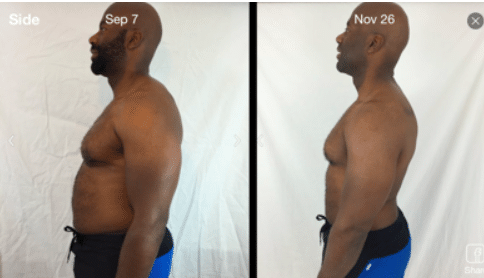
While your body can only build or breakdown fuel at one time, it can switch between phases of being anabolic and catabolic throughout the day. For example, increasing testosterone can help you simultaneously increase lean muscle and decrease fat mass.
For most people chasing simultaneous fat loss and muscle building is the first-class ticket to spin your wheels for weeks and months, hopping from program to program and diet to diet. Go all in with one goal, make it happen, then switch gears.
Execute the Basics
Are you looking for a simple, sustainable plan to lose fat, have more energy, and perform your best? Great. Fill out this short form and we’ll simplify fat loss forever. Apply for the Bach Performance Physique Coaching Program


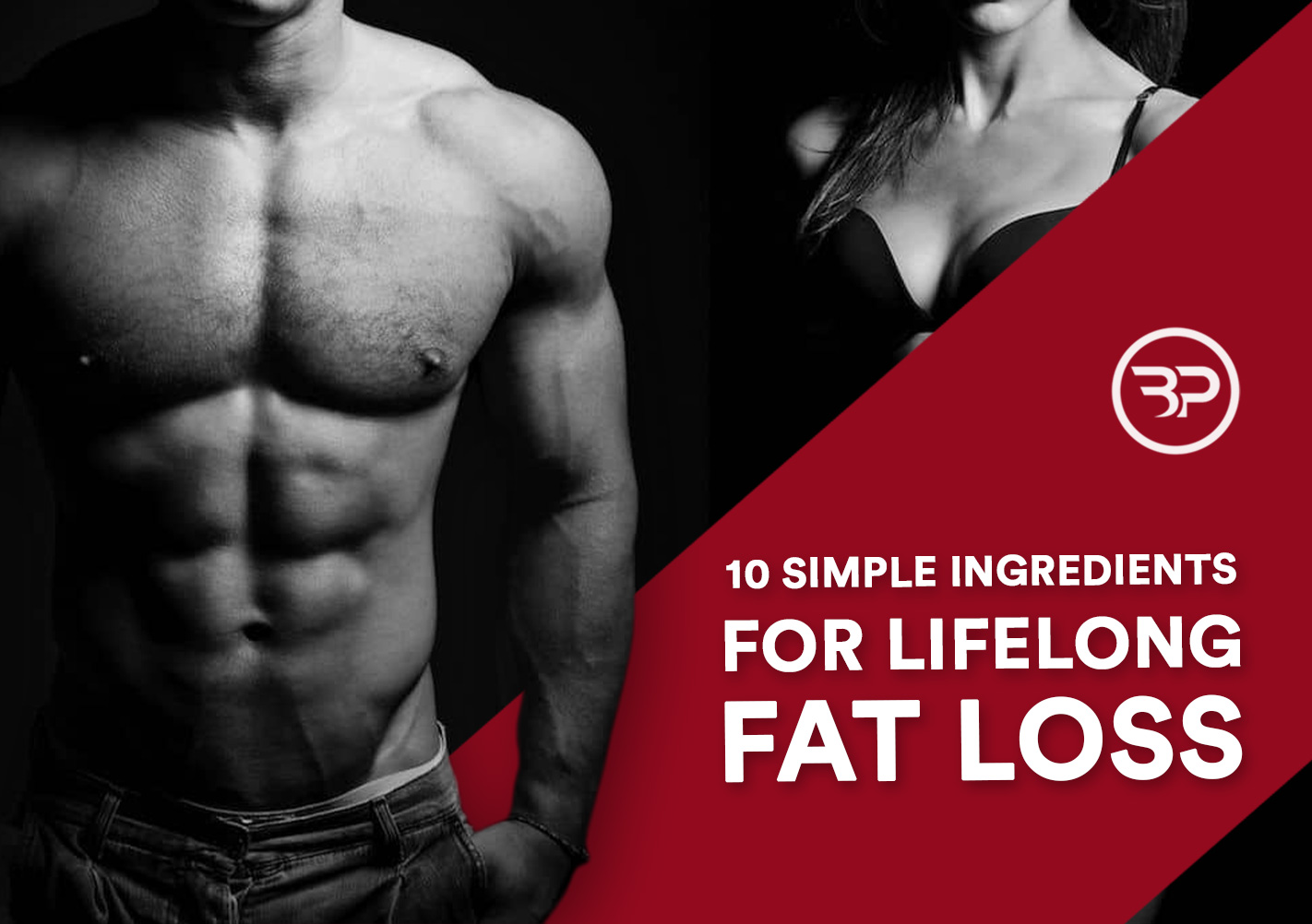







[…] Daily Reading 1. What’s the Difference Between Kipping and Butterfly Pull-ups? 2. Are You Ready To Do Stuff? A Post On Mobility 3. Tip: Boost Performance in 14 Days with this Vitamin 4. 10 Immutable Laws of Fat Loss […]
[…] Eric Bach with the 10 immutable laws of fat loss […]
Great tips! #5 is so true. I used to count calories and it can become a bit of an obsession but these days, I just try to be as healthy as I can and focus on that – no diet as such, basically.
Nice summary of the 10 laws of fat loss. I agree about knowing the reason ‘why’ you want to lose weight. I heard someone say it’s never about health actually, it’s about looking good and attracting the opposite sex, because that’s what makes us feel good 🙂
Thanks so much for this post.I must spend a while learning much more or working out more. Thanks for magnificent info I was looking for this information for my mission.
Stubborn fat loss for women
This article went into a lot of detail about the 10 laws of effective fat loss. Number 9 is what really stood out to me in that lifting while on a fat loss plan is crucial to maintaining your muscle mass. Good job Eric Bach
Thank you, Andre.
[…] https://bachperformance.com/10-immutable-laws-successful-fat-loss/ […]
[…] This post provides you with the principles and tools to succeed in losing fat and looking better naked. […]
Training harder helps, but caloric expenditure during exercise itself plays a much smaller role in losing that than most are willing to admit. I’m all for training hard, but the biggest differences come from adjusting your diet.
Also, did you blindly just attach a random article to drive traffic back to your website?
C’mon bro. And we will not be publishing your guest post.
I love the law of reverse dieting. It sucks if you do everything right and then stop seeing results. It happened to me and reverse dieting got me back on track. Very helpful. Thank you!
Useful and practical tips for weight loss
[…] Counting drop sets, reps schemes, and plates on the bar are February 6, […]
[…] specifically at fat loss, intermittent fasting leverages a time-sensitive eating window to create a caloric deficit, which is the most factor for fat […]
[…] fat loss is your primary goal, getting more protein than the average person has three huge […]